#portrait of julie manet by pierre-auguste renoir
Text


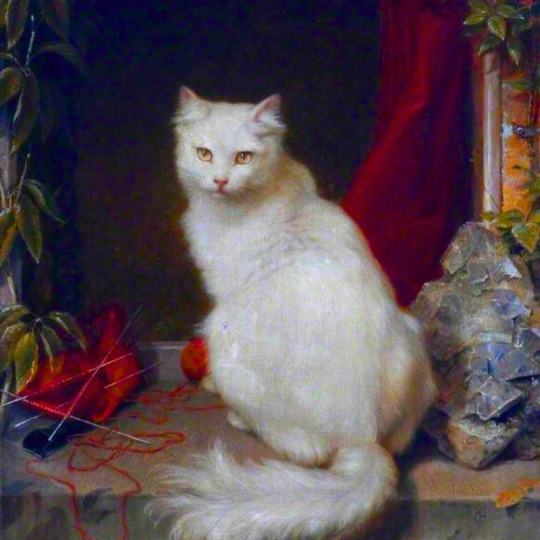





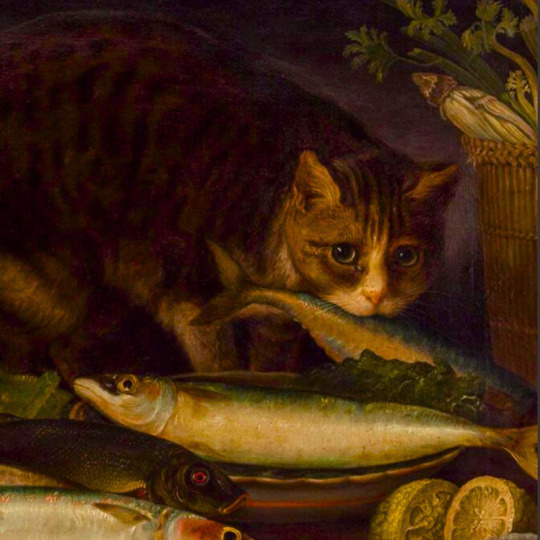


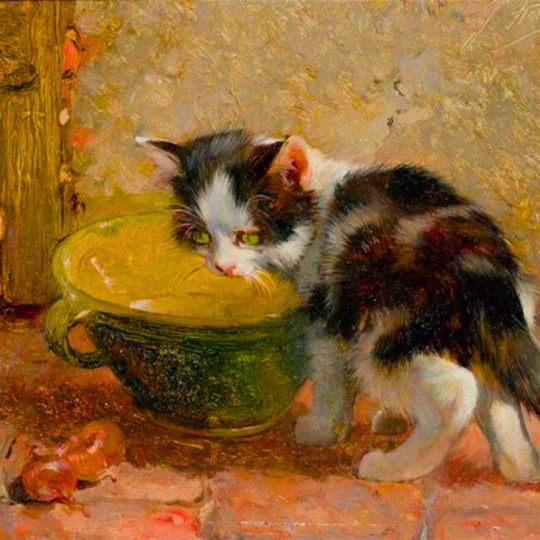
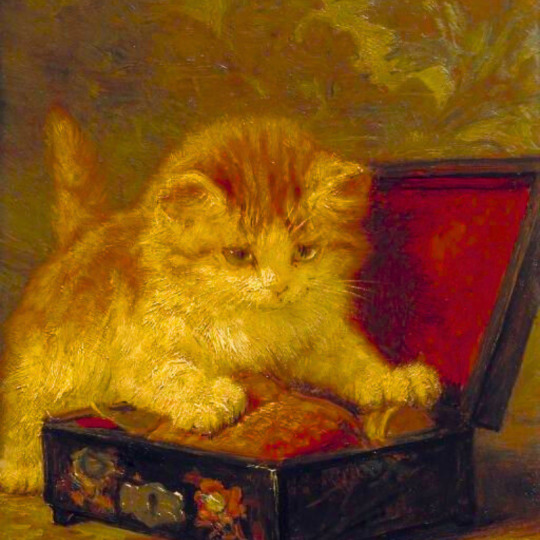
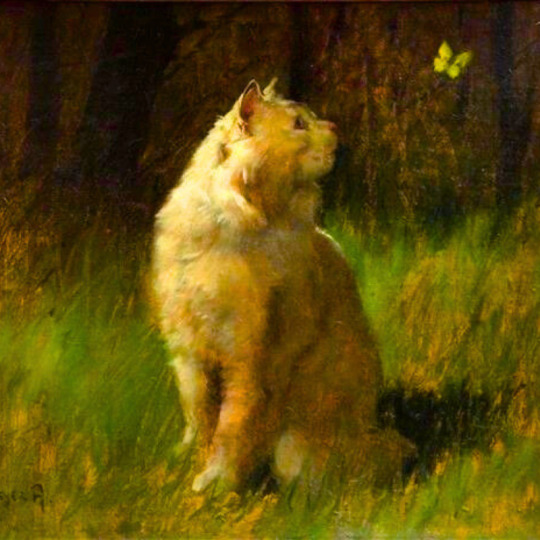
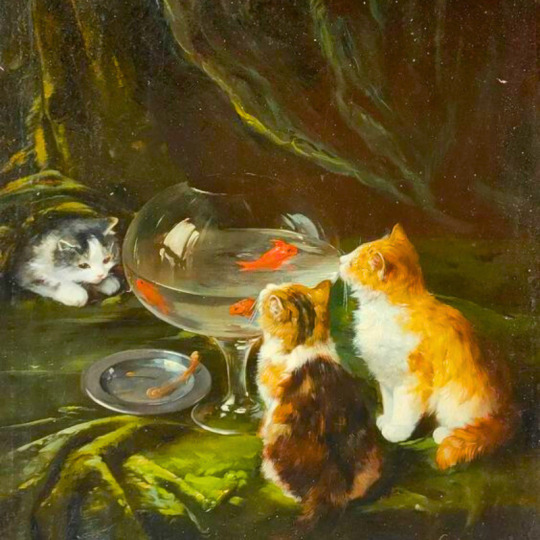
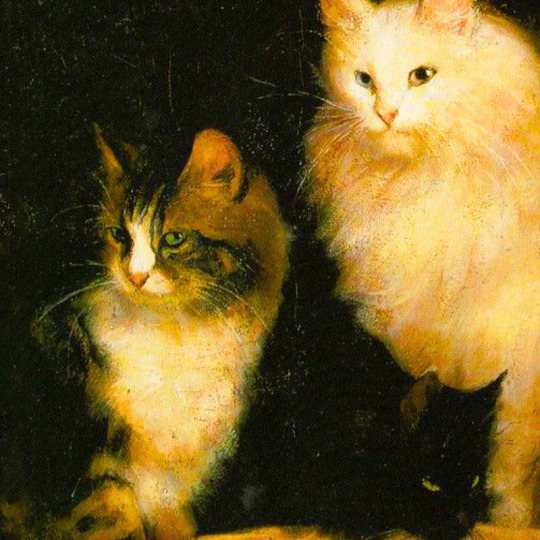
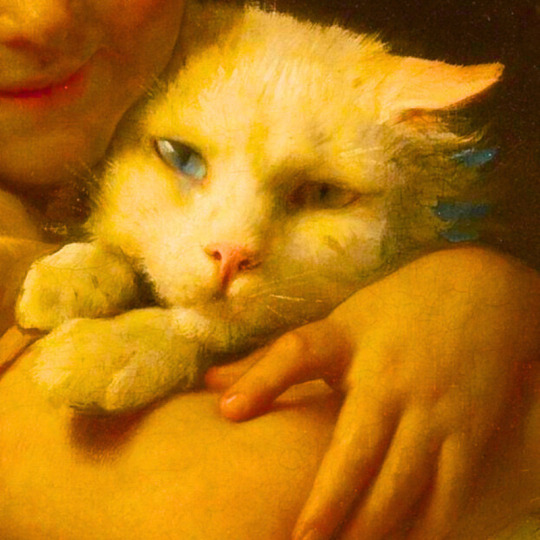
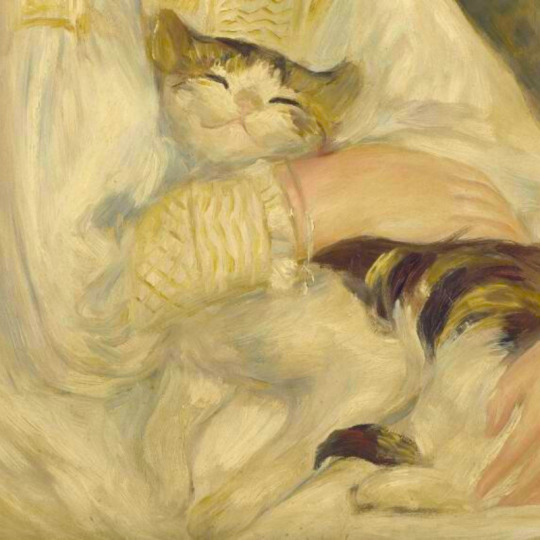
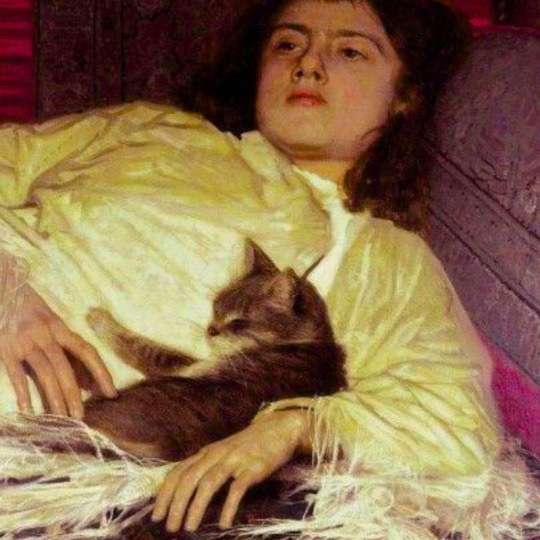

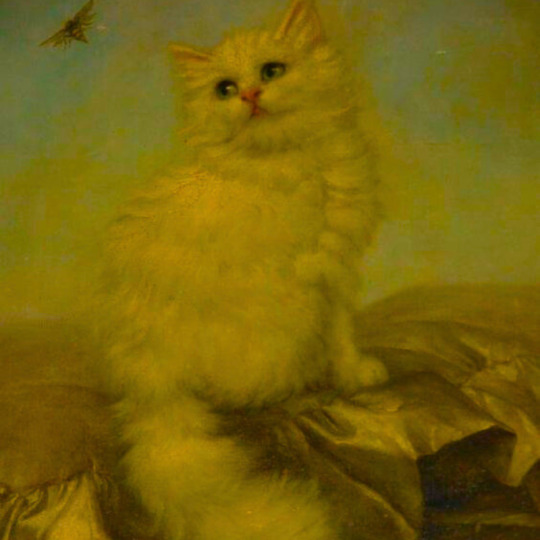
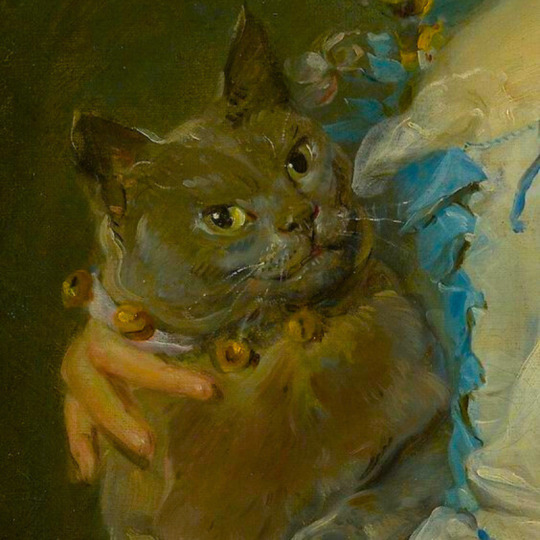
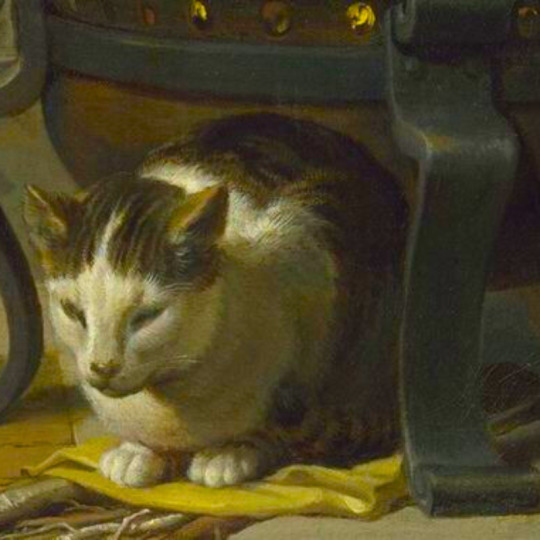

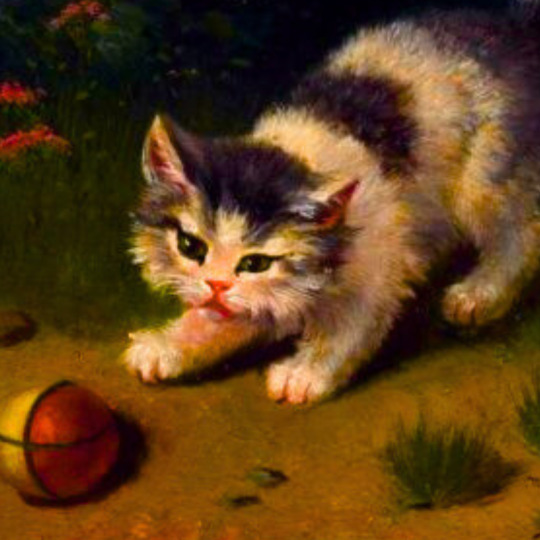
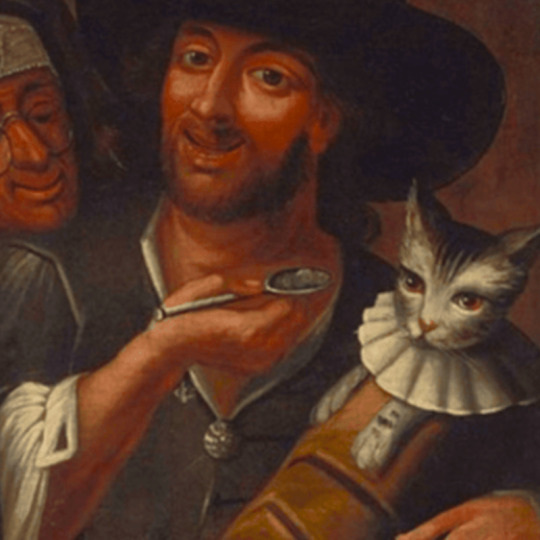
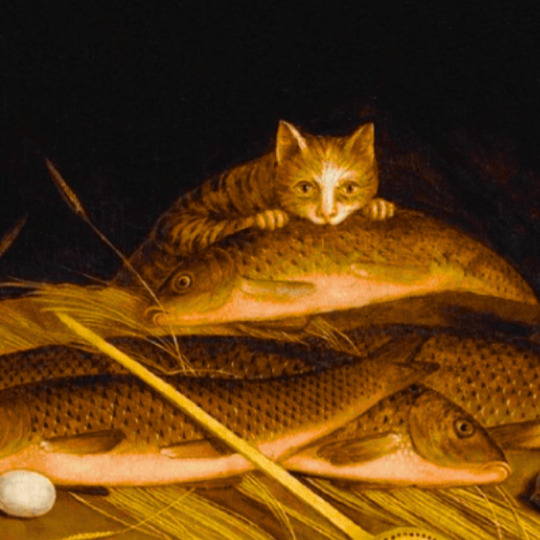

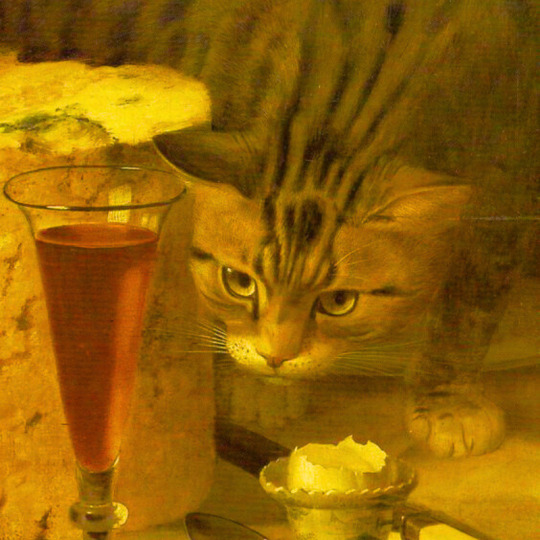

cats + art
#i cant find the artist or the name of this one#let chat angora by jean honore fragonard#no title but by clement burlison#can't find title but its by albert ranney chewett#for these i cant seem to find the titles but i do know the artists#but this one is by arthur rackham#cat churning butter 14th century germany#carl kahler is the artist but he did all cat paintings so i cant find the exact name#in a roman osteria by carl heinrich bloch#still life with a cat and a mackerel on a table top by giovanni rivalta#feline friends by agnes m cowieson#the butterfly and the cat by lily martin spencer#katzchen am fressnapf by julius adam the younger#the sewing box by henriette ronner#white cat watching a butterfly by arthur heyer#the milk dish by alfred brunel de neuville#the first lap by helen cridland#best friends by leon jean basile perrault#portrait of julie manet by pierre-auguste renoir#girl with cat by nikolaevich kramskoy#the nosegay by ford madox brown#my wife's lovers by carl kahler#magdeleine pinceloup de la grange nee de parseval by jean-baptiste perronneau#the sleep of the child jesus by charles le brun#jeune femme et petit garcon tenant un chat by john hoppner#cat and a toy ball by sophie wohl sperlich#a man feeding a cat by unknown#kitchen still life with fish and cat by sebastian stoskopff#two young women wrapped in yukata after a bath by kitagawa utamaro#the trespassers surprise by morley e
2K notes
·
View notes
Text
SET TWELVE - ROUND ONE - MATCH TWO
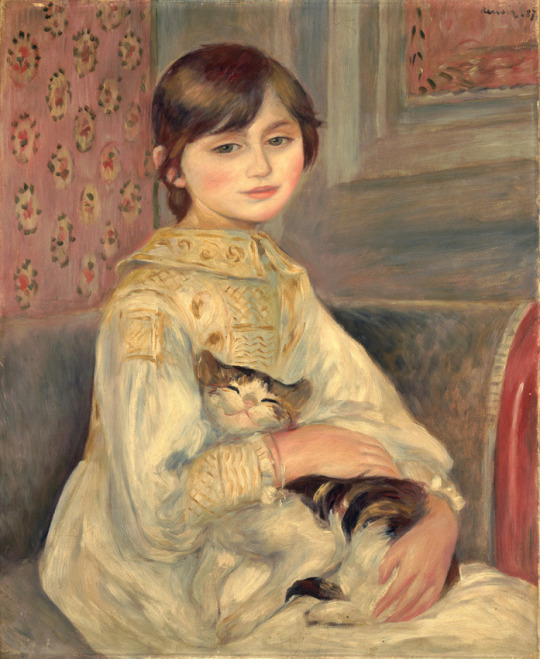
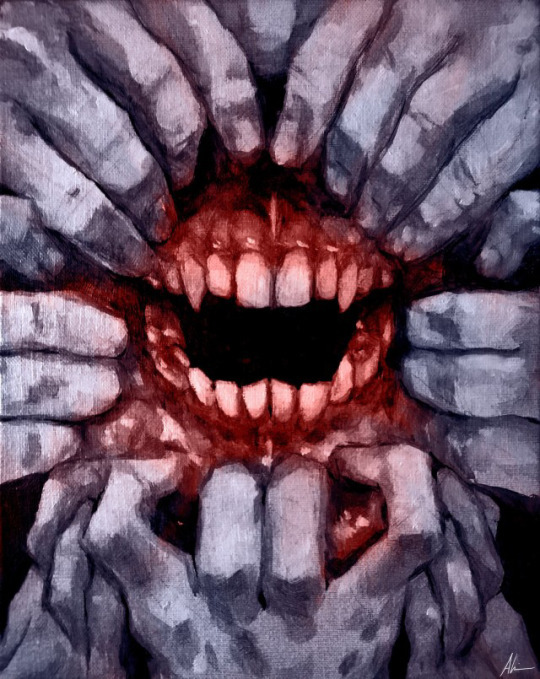
"Julie Manet" (1887 - Pierre-Auguste Renoir) / “Mouth” (2023 - Alin Dobos)
JULIE MANET: Julie Manet was the only child of Berthe Morisot, one of the core members of the impressionist movement, which in the beginning was just a bunch of friends, and Eugène Manet, the brother of Éduard Manet, another important figure in the movement. As a child, she grew up in the middle of the group, shadowing her mother, often painted by her, but also occasionally by others, like this one! Julie’s parents died when she was a teenager – her father in 1892, when she was only fourteen, five years after this painting, and her mother three years later of pneumonia, whilst Morisot was caring for a sick Julie. From the period prior to Morisot’s death, there are portraits of Julie, daydreaming, sad, mourning. Paintings of a mother seeing her baby growing up. This painting is by Renoir, who was a dear family friend of the Morisot-Manet household, and another core impressionist. He was a present throughout Julie’s whole life, outliving her parents, and being there when they weren’t able to be. After Julie’s death, her journal was published, in which she writes about Renoir’s reaction to the death of her mother:
"Jean told me that his father [Renoir] was painting alongside Cézanne in that March when Renoir heard the news of Maman's death. He closed his paintbox and took the next train to Paris. I have never forgotten the way he arrived in my room in the rue Weber and held me close to him; I can still see his white cravat with its little polka dots."
This was a girl who was loved and was as safe in the arms of the painter, as that little cat was in hers, all those years ago. (@hooseiche)
MOUTH: In the description you said something along the lines of “art that makes you want to do unspeakable things”… well, this one definitely does. I want nothing more than to reach my hand into that mouth and touch the flesh. I want to pull at the teeth and cut my fingers on them and touch the gums. I want it to eat my hand and I want to tear chunks off of the mouth and squeeze them in my fists. The texture in this piece is amazing— the teeth look rough and sharp and the gums look soft and wet. I can easily look at this picture and imagine the textures. And the contrast between the teeth and the void of the mouth make it so enticing to reach in and want to discover what lies beyond.
In sum, it makes me go feral and I just want to crumple it up and rip it apart and eat it (affectionately). (@thegirlsinthecity)
("Julie Manet" or "L'enfant au chat" is an oil on canvas painting by Pierre-Auguste Renoir. It measures 650 mm (25.59 in) x 540 mm (21.25 in) and is located in the Musée d'Orsay, Paris. There are several paintings of Julie Manet done by different French impressionist painters.
"Mouth" is painting by Alin Dobos, posted to artstation in 2023.)
#art that fucks you up tournament#polls#atfyu polls#id in alt text#cw horror#cw eye contact#cw blood
79 notes
·
View notes
Text
Happy birthday to Pierre-Auguste Renoir.

Child With Cat
Pierre-Auguste Renoir
1887
The child in this portrait is Julie Manet, daughter of artists Berthe Morisot and Eugène Manet (brother to artist Édouard Manet). I love how happy the little calico looks.

Gabrielle Renard and Jean
Pierre-Auguste Renoir
1895-1896
Gabrielle Renard was a frequent model for Renoir as well as the nanny of Jean, who was Renoir’s son. I love the peaceful domesticity of this. The way she smiles as she supports and plays with Jean, and the way Jean appears to be saying something, even if it’s just baby burble, with a slight smile. It’s just so human.

Luncheon of the Boating Party
Pierre-Auguste Renoir
1880-1883
I like the little dog on the table, how it seems to be leaning back with an air of “leave me alone”.
5 notes
·
View notes
Text

Artist: Pierre-Auguste Renoir
Location: Musee d'Orsay
Periods: Impressionism, Modern art
Creation date: 1887
The teenager who tenderly cuddles a cat in Pierre Auguste Renoir's 1887 painting, "Girl with a Cat" preserved at the Musée d'Orsay, is Julie Manet, only daughter of Berthe Morisot, the great impressionist painter, and Eugène Manet , also a painter, like his illustrious older brother Édouard, who did not experience the same notoriety.
Julie Manet (1878-1966), growing up surrounded by so much beauty, and with an impressionist education, could not help but inherit a great passion for art and take up the brush in her turn.
In 1900 she married the painter Ernest Rouart, son of Henri, whom she had met at the Louvre three years earlier, and with her husband she assembled an important collection, with artists such as Corot, Fragonard, Hubert Robert and Gauguin, of which she donated in part to Louvre.
She also spent her entire life promoting her mother's work.
The Musée Marmottan-Monet is dedicating the exhibition «Julie Manet.
The impressionist memory", retracing her life in more than one hundred works, including the portraits painted by Berthe Morisot, who painted her when she was a child, while she played in the meadows, and as a young woman with long brown hair.
Julie also posed for her uncle Édouard Manet, for Renoir, who took care of her when she was orphaned in 1895 at the age of sixteen, and, of course, for her husband.
And it was under Renoir's guidance that Julie also learned to paint and the Marmottan exhibited some of her works, including «Femme avec Laërte», exhibited in the Salon des Indépendants of 1898.
Artista: Pierre-Auguste Renoir
Luogo: Musée d'Orsay
Periodi: Impressionismo, Arte moderna
Data di creazione: 1887
L’adolescente che stringe teneramente a sé un micio nel dipinto del 1887 di Pierre Auguste Renoir, «Bambina con gatto» conservato al Musée d’Orsay, è Julie Manet, unica figlia di Berthe Morisot, la grande pittrice impressionista, e di Eugène Manet, pittore anch’egli, così come l’illustre fratello maggiore Édouard, che non conobbe la stessa notorietà.
Julie Manet (1878-1966), crescendo circondata da tanta bellezza, e con un’educazione impressionista, non poté non ereditare una grande passione per l’arte e prendere a sua volta in mano il pennello. Nel 1900 sposò il pittore Ernest Rouart, figlio di Henri, conosciuto al Louvre tre anni prima, e con il marito riunì un’importante collezione, con artisti come Corot, Fragonard, Hubert Robert e Gauguin, di cui fece in parte dono al Louvre.
Passò inoltre tutta la vita a promuovere l’opera della madre. Il Musée Marmottan-Monet le dedica fino al 20 marzo la mostra «Julie Manet. La memoria impressionista», ripercorrendone la vita in più di cento opere, tra cui i ritratti eseguiti da Berthe Morisot, che la dipinse quando era bimba, mentre giocava nei prati, e da giovane donna dai lunghi capelli castani.
Julie posò anche per lo zio Édouard Manet, per Renoir, che si prese cura di lei quando nel 1895, sedicenne, rimase orfana, e, naturalmente, per il marito. E proprio sotto la guida di Renoir anche Julie imparò a dipingere e il Marmottan espone alcuni dei suoi lavori, tra cui «Femme avec Laërte», esposto nel Salon des Indépendants del 1898.
1 note
·
View note
Text
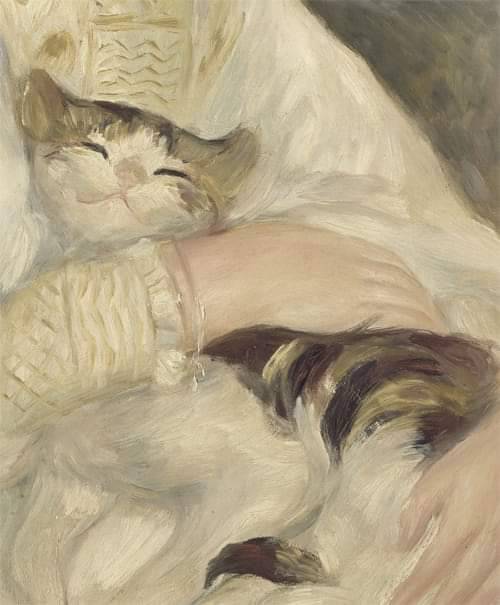
Julie Manet with cat ~ Pierre-Auguste Renoir (1887); art detail
Location: Musée d'Orsay
#renoir#french art#french artist#impressionism#pierre-auguste renoir#julie manet with cat#art#art detail#cats#catlover#animals#animals in art#1800s art#1800s#late 1800s#painting#oil on canvas#portrait#Musée d'Orsay#french#paintings#beauty#beauty will save the world#cute#so cute
584 notes
·
View notes
Photo


L'art en confinement. 16. Portrait de Berthe Morisot et de sa fille Julie Manet, Pierre-Auguste Renoir, (1894), collection particulière.
1 note
·
View note
Photo

Pierre Auguste Renoir-Portrait de Julie Manet
What is it about this work that resonates with you? I am impressed by the melancholy that the young woman’s face reflects and how the painter plays with other elements such as light, shadows, costume to highlight the young girl’s melancholy.
What do you see in this work? A beautiful and melancholic young woman.
What words would you use to describe this work? Somber and beauty.
What things do you recognize in this piece of work? What things seem new to you? The importance of the nuances in the light and shadows in an image.
What is the key visual aspect that I recognize? The painter uses three important aspects, her clothing, her facial expression, and the play with light and shadows.
What does this painting remind me of? I think this is a naturalistic photograph.
How has the artist captured light play in this image? The light plays an important role in this picture. The painter through his brush , tones and colors created light and shadows that gives the picture a sombre atmosphere.
How is space represented in this painting? In my opinion, I think the girl is not well framed because there is an excess of space on her right side.
What techniques and processed have been used to make the image? Contrary to most Renoir works, this is not a colorful painting. He uses dark colors like black, ocre and brown. He also uses bold contrasting lineal strophes.
How is this picture different from real life? Because in this painting not only we see a very beautiful young lady, but also we see how the artist paintus her. We see how the painter interprets and paint what he sees.
1 note
·
View note
Photo
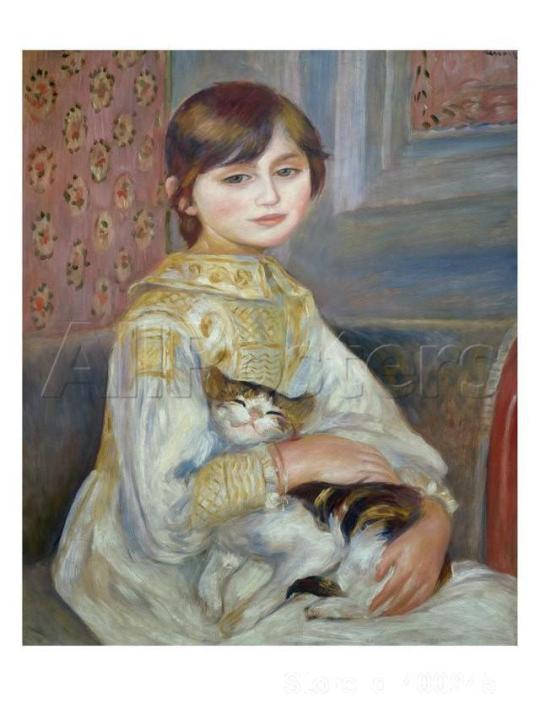
Wall art Portrait of Julie Manet or Little Girl with Cat by Pierre Auguste Renoir decorative paintings Handmade High quality https://my-artwork.com/product/wall-art-portrait-of-julie-manet-or-little-girl-with-cat-by-pierre-auguste-renoir-decorative-paintings-handmade-high-quality/
2 notes
·
View notes
Photo

Julie Manet (L'enfant au chat)
Origin: France, 1887.
Description: Julie Manet’s parents commissioned Pierre Auguste Renoir to paint her portrait in the late 1880s when she was nine. Her parents were also artists, and the family had become close friends with Renoir, who lead the development of the Impressionist style. Julie would frequently pose for her mother and other artists, and would herself become a painter. Here she sits with a very contented cat in her lap, successfully conveying the sensitivity and affection of his young muse. On display at the Musée d'Orsay.
#cat#cats#cats in history#cat history#art history#cats in art#french art#julie manet#renoir#pierre auguste renoir#musee d'orsay#19th century#france
62 notes
·
View notes
Text
10 Artists Who Were Also Mothers
Who said that you can’t be a mother and an artist at the same time?
The patriarchy, for one, but surprisingly, a lot of female artists as well. Even artists like Mary Cassatt and Judy Chicago whose work primarily featured themes of motherhood and femininity never had children because they believed it would compromise the quality of their art. But there were actually a handful of successful female artists who were also pretty good mothers, they just seldom get the credit for doing both. For Mother’s Day -which should really be everyday- we’re celebrating our favorite badass moms who significantly impacted the art world.
Artemisia Gentileschi

Madonna and Child, Artemisia Gentileschi, 1613
Artemisia Gentileschi had one daughter with two names- Prudentia (after her mother who passed away early in Artemisia’s childhood) and Palmira. She had her daughter very early on in her career and continued to paint up until her death when her daughter was well into adulthood. Like her mother, Prudentia/Palmira also became a painter, though none of her works are currently known.
Judith Leyster
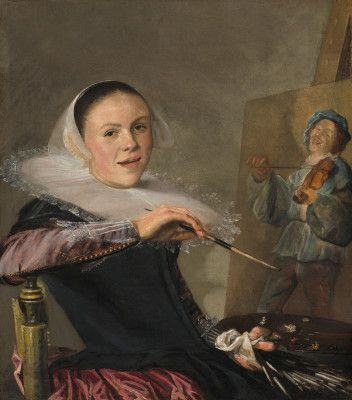
Self-Portrait, Judith Leyster, 1630
Not too much is known about Judith Leyster. She didn’t really get recognition for her paintings for a while as they were usually credited to the “Wife of Molenaer” who was a more famous painter at the time. Leyster had five children with Molenaer, but only two survived into adulthood. With the information on her surviving dated works, it looks like Leyster wasn’t as prolific once she got married and had children, but she still continued to paint up until a few years before her death in 1660.
Louise Élisabeth Vigée Le Brun
“The beauty of her heavenly face, that expressed benevolence and goodness, and whose features were so regular and delicate, the loveliness of her figure, neck, and arms, the exquisite freshness of her complexion – all was enchanting beyond anything imaginable”
-Vigee le Brun describing her daughter in her diary.
Self Portrait with her Daughter Julie, Louise Élisabeth Vigée Le Brun, 1786
Self Portrait with Her Daughter, Julie, Louise Élisabeth Vigée Le Brun, 1789
Louise Élisabeth Vigée Le Brun had one child, Jeanne Julie Louise, who she nicknamed “Brunette.” Vigee Le Brun’s first self portrait of her and Julie caused a scandal when it was exhibited simply because she was depicted smiling open-mouthed -- how dare she be visibly happy with her child?! During the French Revolution, Vigee Le Brun fled France with Julie to Italy, Austria, and then finally Russia. It was in Russia that their relationship crumbled; Julie married a man that her mother strongly disapproved of, and Elisabeth Louise then shunned her from her life, refusing to provide for her daughter when both were back in France. It's hard to read that the two had such a strained relationship when looking at these adorable self-portraits.
Berthe Morisot
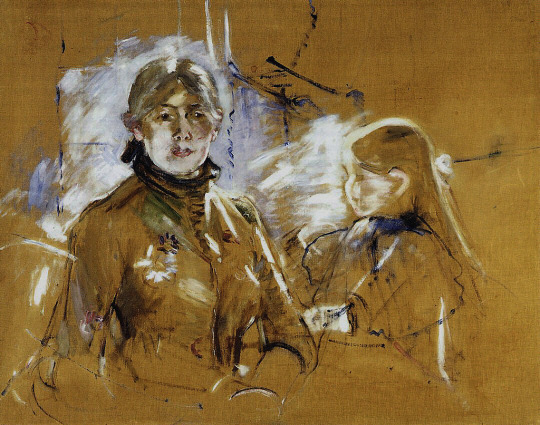
Portrait of Berthe Morisot and Her Daughter, Berthe Morisot, 1885
Berthe Morisot and her daughter, Pierre Auguste-Renoir, 1894
Apparently Julie is a popular name for the daughters of female artists. Impressionist painter Berthe Morisot married Edouard Manet’s younger brother Eugene and had her only child Julie Manet, who often posted as a model for Morisot and other Impressionists. When Julie was 16 she became ill with influenza (get your shots people!). Morisot eventually got the same infection by taking care of Julie and subsequently died not long after. Morisot’s devotion to her daughter literally killed her.
Suzanne Valadon

Suzanne Valadon with her son Maurice Utrillo, 1889
Suzanne Valadon and Maurice Utrillo, 1930
Suzanne Valadon wasn’t just a mom, she was a single mom! She had her son Maurice when she was an 18-year-old model for artists. Her mother Madeleine helped take care of Maurice, and the two often served as models for Valadon’s domestic sketches that gave her recognition and critical acclaim. Maurice was a troubled alcoholic suffering from mental illness, and it was his mother who encouraged him to try painting. Not too long after, Maurice ended up being a successful artist himself! Mother truly knows best.
Barbara Hepworth
“My studio was a jumble of children, rocks, sculptures, trees, importunate flowers, and washing.”

Barbara Hepworth with her son Paul, 1929
The Hepworth triplets: Simon, Rachel, and Sarah, 1937
Barbara Hepworth with her daughters Rachel and Sarah, 1965
Barbara Hepworth was the ultimate mom/artist. She raised four children while working along her husband Ben Nicholson in the St. Ives artists’ colony. She often wrote about how being a mother and an artist was never a conflicting process and that having a family actually improved the quality of her sculptures. Her eldest son Paul was killed in a plane crash in 1953, prompting a devastated Hepworth to take a trip to Greece with a good friend. When she came back, her sculptures had a distinctly Greek influence. Her son Simon was also an artist, but died young from alcoholism. Her daughter Sarah married Sir Alan Bowness, former director of the Tate Gallery. Both she and her sister Rachel are in charge of their mother’s estate.
Louise Bourgeois
“They had two children fairly quickly, then a third one shortly thereafter. There was no room, really, to do sculpture in the apartment. So she painted.”
-Jerry Gorovoy, assistant to Louise Bourgeois

With her three sons in Easton, CT, 1945
Louise Bourgeois had three children within the span of three years! She and her husband Robert Goldwater adopted Michel from France in 1939, then she gave birth to Jean-Louise in 1940 and Alain in 1941. Despite having her hands and her house full, she didn’t give up on her artwork and continued to create paintings, drawings, and sculptures until her death in 2010. She is survived by her sons Alain and Jean-Louise, an architectural expert on Adobe who recently donated his $4 million house to Native Americans as a meeting house. Louise would have been proud.
Yoko Ono
“Mothers are not supposed to give guidance.”

Yoko Ono and John Lennon with their children from previous marriages, Julian Lennon and Kyoko Chan Cox
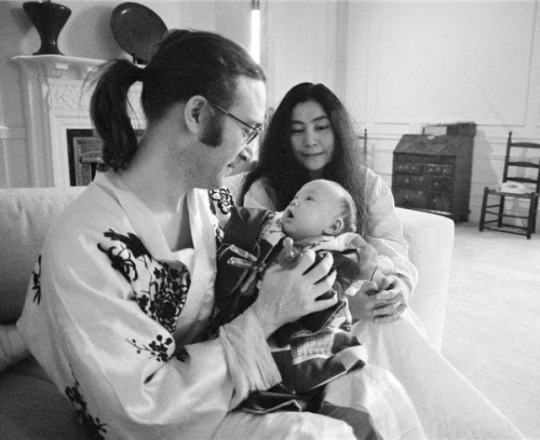
Yoko Ono and John Lennon with their son Sean Lennon
Avant-garde artist Yoko Ono had her daughter Kyoko with her second husband Anthony Cox. Not longer after she filed for divorce and met John Lennon. When Kyoko was eight, she and Cox disappeared in the middle of a custody battle; Ono was unable to find Kyojo until she was 35. Lennon and Ono had one child, Sean Lennon, who is currently pursuing music with his band “The Ghost of a Saber Tooth Tiger.”
Jenny Holzer
“When my daughter was young, she thought all electronic signs were mine.”

Jenny Holzer with her family in the Central Park Zoo, 1990
Jenny Holzer with Lili Holzer-Grier, 2011
Jenny Holzer gave birth to Lili Holzer (now Holzer-Grier) in 1989. Her daughter’s birth inspired Holzer’s works Laments and Truism 4 (Mother and Child) in 1990. Lili Holzer-Grier is now a successful photographer based in New York, where her mother also currently lives. Both Holzer's and her daughter’s artwork portray American hypocrisy and injustice.
Kara Walker
“My mother is a mother. And an artist. And the two never felt like they were incompatible.”
-Octavia Brugel on her mother Kara Walker
Kara Walker with baby Octavia

Kara Walker and Octavia in 2016
Kara Walker had her daughter Octavia early in her career, showing us that it really isn’t impossible to gain international fame in the art world while raising a child. Walker incorporated her daughter’s voice into 8 Possible Beginnings to help demonstrate how the heritage of American slavery affects women of color as artists. Octavia is now a photographer studying at Oberlin College.
Of course, you don’t have to be a successful artist to be a successful mom. Shout-out to all mothers out there who are able to juggle both their careers and their children. And an additional thanks to mothers everywhere for being awesome women and continually inspiring us all to produce and admire great art. “Mom” upside-down spells “wow” for a reason! Now go call your mom and tell her you love her.
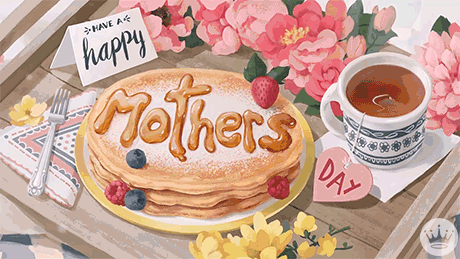
By Alannah Clark
#mothers day#mom#mothers#moms in art#female artists#women in art#5 women artists#art history#history of art#art#artemisia gentileschi#judith leyster#louise Élisabeth vigee le brun#berthe morisot#suzanne valadon#barbara hepworth#louise bourgeois#yoko ono#jenny holzer#Kara Walker
1 note
·
View note
Photo
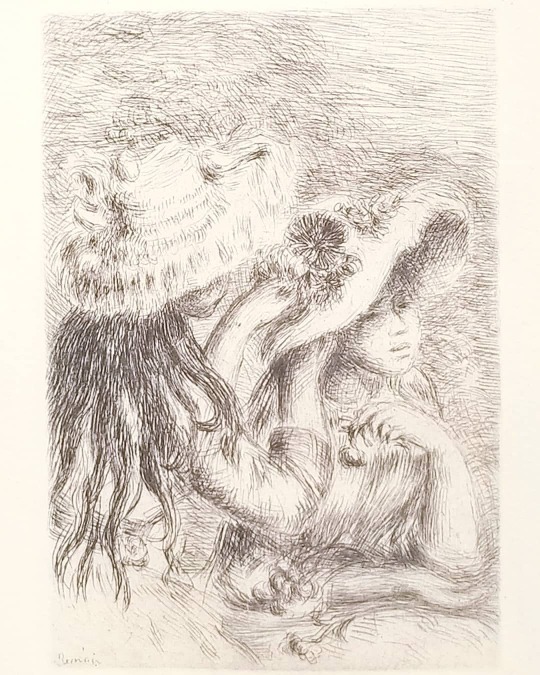
"Le Chapeau Epingle (The Pinned Hat)" original c.1894 etching by Pierre-Auguste Renoir will be on exhibition next Friday at "An Evening In Paris". This rare etching is from the 2nd state (of three), published in 1921, with large margins on wove paper. Renoir's models are known to have been Julie Manet, the daughter of Berthe Morisot and niece of Eduard Manet, and her cousin, Paulette Gobillard. Image: 4.75 x 3.25" Framed:14.5 x 17.75" This etching was commissioned by Dentu in Paris in 1894 for Gustave Geffroy's art journal, La Vie artistique. It later appeared in Georges Riviere's, Renoir et ses Amis, published in Paris in 1921. It should also here be noted that there are a number of modern re-strikes of this famous etching. Pierre-Auguste Renoir did not make prints until he was almost fifty years old, after he was an established Impressionist painter renowned for his bathers, landscapes, and portraits of the Parisian leisure class. Between about 1890 and 1908 he made approximately sixty prints—roughly half of them etchings and half lithographs—most of which were commissioned for books or albums. Discussion: "The themes of Renoir's original prints are very much akin to those of his paintings; scenes of people he admired, children, bathers, nudes -- all examined in the ever changing light of the moment. His models are known to have been Julie Manet, the daughter of Berthe Morisot and niece of Eduard Manet, and her cousin, Paulette Gobillard. The scene originated from a study Pierre Renoir made while on holiday on the coast of Northern France with Berthe Morisot and her family. Julie Manet was a favourite model for Renoir and on this occasion he drew her on the beach with her cousin who was adjusting the pin on her large sun hat." #fineart #renoir #art #arts #etching #pierreaugustrenoir #lechapeauepingle #renoirart #renoiretching #artgallery #museum #keywest #keywestgallery #impressionists #modernart #impressionist #louvre #artlover #artopening #manet #arthistory #frenchart #finearts #artfollower #fineartcollector #artcollecting #parislove (at Art of Kreg D Kelley) https://www.instagram.com/p/B6ZnjnaBMJU/?igshid=g3vsu3vsj2xy
#fineart#renoir#art#arts#etching#pierreaugustrenoir#lechapeauepingle#renoirart#renoiretching#artgallery#museum#keywest#keywestgallery#impressionists#modernart#impressionist#louvre#artlover#artopening#manet#arthistory#frenchart#finearts#artfollower#fineartcollector#artcollecting#parislove
0 notes
Text
0 notes
Photo

“It is important to express oneself… provided the feelings are real and are taken from your own experience.”-Berthe Morisot
Berthe Morisot was born on this day in 1841. She died on March 2, 1895.
In 1894, famed art critic Gustave Geffroy described Berthe Morisot, Marie Bracquemond, and Mary Cassatt as “les trois grandes dames” (the three great ladies) of the Impressionist movement.
Born into a wealthy bourgeois family from Bourges, France, Berthe Morisot learnt how to paint at an early age, having private lessons along with her sisters.
As art students, Berthe and her sister Edma would spend hours in the Louvre copying the great works.
While marriage and family life ended Edma’s art career, Berthe continued to paint, and in 1864 at age 23, she exhibited at the prestigious Salon de Paris—the official, annual exhibition of the Académie des beaux-arts in Paris.
Then in 1874, she stopped exhibiting with the academy and joined the Impressionists, which included Paul Cézanne, Edgar Degas, Claude Monet, Camille Pissarro, Pierre-Auguste Renoir, and Alfred Sisley.
Regarded as a “virtuoso colorist”, Berthe created a sense of space and depth with color, painting what she saw and experienced in everyday life. But there is a message in her work—one that tells a story of the class and gender restrictions of the 19th century.
Focusing on family life, her portraits often feature her own daughter, Julie, from her marriage to Édouard Manet’s brother, Eugène.
To view 30 of her paintings: http://fiveminutehistory.com/berthe-morisot-one-of-the-three-great-ladies-of-impressionism/
Other source: http://www.arthistoryarchive.com/arthistory/impressionism/Berthe-Morisot.html, which is also an excellent source for information on Morisot, including that her paintings now go for more than four million dollars.
0 notes
Text
The Biggest Contribution Of Claude Monet Reading To Humanity | Claude Monet Reading
The Biggest Contribution Of Claude Monet Reading To Humanity | Claude Monet Reading – Oscar-Claude Monet (UK: /ˈmɒneɪ/, US: /moʊˈneɪ/, France: [klod mɔnɛ]; 14 November 1840 – 5 January 1926) was a France painter, a creator of French Impressionist painting and the the majority of consistent and abundant practitioner of the movement’s philosophy of providing one’s perceptions before nature, especially since applied to plein atmosphere landscape painting. The word “Impressionism” is derived from it of his artwork Impression, soleil levant (Impression, Sunrise), that was exhibited in 1874 in the first of the independent exhibitions mounted by Monet and his associates as an alternative to the Salon de Venice.
Monet’s ambition associated with documenting the German countryside led your pet to adopt a method of artwork the same scene sometimes in order to capture the changing of light along with the passing of the gardening seasons. From 1883, Monet lived in Giverny, just where he purchased a house and property as well as began a vast landscape designs project which included lily ponds that would this would subjects of his best-known works. Within 1899, he began art work the water lilies, first in vertical views with a Japanese passage as a central element and later in the group of large-scale paintings that was to occupy him or her continuously for the next twenty years of his life.
From the late 1860s, Monet and other like-minded artists met together with rejection from the conservative Académie des Beaux-Arts, which held the annual exhibition on the Salon de Paris. During the latter section of 1873, Monet, Pierre-Auguste Renoir, Camille Pissarro, and Alfred Sisley organized the Société anonyme des histrion peintres, sculpteurs ainsi que graveurs (Anonymous Community of Painters, Sculptors, and Engravers) to demonstrate their artworks separately. At their initially exhibition, held in Apr 1874, Monet showed the work that was to give the group its long lasting name. He was motivated by the style as well as subject matter of previous modern painters Camille Pissarro and Edouard Manet.
Impression, Dawn was painted inside 1872, depicting some sort of Le Havre interface landscape. From the painting’s title the art work critic Louis Leroy, in his review, “L’Exposition des Impressionnistes, ” which appeared in Le Charivari, created the term “Impressionism”. It turned out intended as brand but the Impressionists appropriated the term for themselves.
Franco-Prussian War and Argenteuil
After the outbreak from the Franco-Prussian War (19 July 1870), Monet and his family needed refuge in England within September 1870, exactly where he studied the works of John Constable and Frederick Mallord William Turner, both of whose areas would serve to motivate Monet’s innovations from the study of coloring. In the spring involving 1871, Monet’s works were refused authorisation for inclusion in the Royal Academy exhibit.
In May 1871, he left London to live in Zaandam, from the Netherlands, where selection twenty-five paintings (and the police suspected the dog of revolutionary activities). He also given a first visit to neighbouring Amsterdam. In July or November 1871, he returned to be able to France. From January 1871 to 1878 he lived at Argenteuil, a small town on the right financial institution of the Seine river near Paris, plus a popular Sunday-outing destination for Parisians, where this individual painted some of their best-known works. Throughout 1873, Monet ordered a small boat loaded to be used as a hovering studio. From the ship studio Monet decorated landscapes and also portraits of Édouard Manet and his wife; Manet in turn depicted Monet painting aboard the boat, accompanied by Camille, inside 1874. In 1874, he briefly arrived to Holland.
Pierre Auguste Renoir – The Complete Works – Claude Monet … – claude monet reading | claude monet reading
The Biggest Contribution Of Claude Monet Reading To Humanity | Claude Monet Reading – claude monet reading
| Welcome to the blog site, within this period I’ll demonstrate about keyword. And after this, this can be a primary impression:
Renoir, Pierre Auguste ( 5-5) – Claude Monet reading … – claude monet reading | claude monet reading
Why don’t you consider photograph above? is that will remarkable???. if you think consequently, I’l t demonstrate a few image once again underneath:
Portrait of Claude Monet Reading, 5 – claude monet reading | claude monet reading
So, if you would like secure these amazing photos related to (The Biggest Contribution Of Claude Monet Reading To Humanity | Claude Monet Reading), press save icon to save the photos to your personal computer. There’re available for obtain, if you love and wish to grab it, just click save logo on the web page, and it’ll be directly down loaded in your pc.} Lastly if you like to grab unique and the latest image related with (The Biggest Contribution Of Claude Monet Reading To Humanity | Claude Monet Reading), please follow us on google plus or bookmark the site, we try our best to offer you regular up grade with all new and fresh photos. Hope you enjoy keeping right here. For some updates and recent information about (The Biggest Contribution Of Claude Monet Reading To Humanity | Claude Monet Reading) graphics, please kindly follow us on tweets, path, Instagram and google plus, or you mark this page on book mark section, We try to offer you up grade regularly with fresh and new pics, like your exploring, and find the right for you.
Pierre-Auguste Renoir Claude Monet reading a newspaper – claude monet reading | claude monet reading
Thanks for visiting our website, contentabove (The Biggest Contribution Of Claude Monet Reading To Humanity | Claude Monet Reading) published . At this time we’re excited to announce that we have found an incrediblyinteresting topicto be discussed, that is (The Biggest Contribution Of Claude Monet Reading To Humanity | Claude Monet Reading) Most people searching for info about(The Biggest Contribution Of Claude Monet Reading To Humanity | Claude Monet Reading) and of course one of them is you, is not it?
File:Pierre August Renoir, Claude Monet Reading cut.jpg … – claude monet reading | claude monet reading
from WordPress https://paintingarta.online/the-biggest-contribution-of-claude-monet-reading-to-humanity-claude-monet-reading/
0 notes
Text
The Biggest Contribution Of Claude Monet Reading To Humanity | Claude Monet Reading
The Biggest Contribution Of Claude Monet Reading To Humanity | Claude Monet Reading – Oscar-Claude Monet (UK: /ˈmɒneɪ/, US: /moʊˈneɪ/, France: [klod mɔnɛ]; 14 November 1840 – 5 January 1926) was a France painter, a creator of French Impressionist painting and the the majority of consistent and abundant practitioner of the movement’s philosophy of providing one’s perceptions before nature, especially since applied to plein atmosphere landscape painting. The word “Impressionism” is derived from it of his artwork Impression, soleil levant (Impression, Sunrise), that was exhibited in 1874 in the first of the independent exhibitions mounted by Monet and his associates as an alternative to the Salon de Venice.
Monet’s ambition associated with documenting the German countryside led your pet to adopt a method of artwork the same scene sometimes in order to capture the changing of light along with the passing of the gardening seasons. From 1883, Monet lived in Giverny, just where he purchased a house and property as well as began a vast landscape designs project which included lily ponds that would this would subjects of his best-known works. Within 1899, he began art work the water lilies, first in vertical views with a Japanese passage as a central element and later in the group of large-scale paintings that was to occupy him or her continuously for the next twenty years of his life.
From the late 1860s, Monet and other like-minded artists met together with rejection from the conservative Académie des Beaux-Arts, which held the annual exhibition on the Salon de Paris. During the latter section of 1873, Monet, Pierre-Auguste Renoir, Camille Pissarro, and Alfred Sisley organized the Société anonyme des histrion peintres, sculpteurs ainsi que graveurs (Anonymous Community of Painters, Sculptors, and Engravers) to demonstrate their artworks separately. At their initially exhibition, held in Apr 1874, Monet showed the work that was to give the group its long lasting name. He was motivated by the style as well as subject matter of previous modern painters Camille Pissarro and Edouard Manet.
Impression, Dawn was painted inside 1872, depicting some sort of Le Havre interface landscape. From the painting’s title the art work critic Louis Leroy, in his review, “L’Exposition des Impressionnistes, ” which appeared in Le Charivari, created the term “Impressionism”. It turned out intended as brand but the Impressionists appropriated the term for themselves.
Franco-Prussian War and Argenteuil
After the outbreak from the Franco-Prussian War (19 July 1870), Monet and his family needed refuge in England within September 1870, exactly where he studied the works of John Constable and Frederick Mallord William Turner, both of whose areas would serve to motivate Monet’s innovations from the study of coloring. In the spring involving 1871, Monet’s works were refused authorisation for inclusion in the Royal Academy exhibit.
In May 1871, he left London to live in Zaandam, from the Netherlands, where selection twenty-five paintings (and the police suspected the dog of revolutionary activities). He also given a first visit to neighbouring Amsterdam. In July or November 1871, he returned to be able to France. From January 1871 to 1878 he lived at Argenteuil, a small town on the right financial institution of the Seine river near Paris, plus a popular Sunday-outing destination for Parisians, where this individual painted some of their best-known works. Throughout 1873, Monet ordered a small boat loaded to be used as a hovering studio. From the ship studio Monet decorated landscapes and also portraits of Édouard Manet and his wife; Manet in turn depicted Monet painting aboard the boat, accompanied by Camille, inside 1874. In 1874, he briefly arrived to Holland.
Pierre Auguste Renoir – The Complete Works – Claude Monet … – claude monet reading | claude monet reading
The Biggest Contribution Of Claude Monet Reading To Humanity | Claude Monet Reading – claude monet reading
| Welcome to the blog site, within this period I’ll demonstrate about keyword. And after this, this can be a primary impression:
Renoir, Pierre Auguste ( 5-5) – Claude Monet reading … – claude monet reading | claude monet reading
Why don’t you consider photograph above? is that will remarkable???. if you think consequently, I’l t demonstrate a few image once again underneath:
Portrait of Claude Monet Reading, 5 – claude monet reading | claude monet reading
So, if you would like secure these amazing photos related to (The Biggest Contribution Of Claude Monet Reading To Humanity | Claude Monet Reading), press save icon to save the photos to your personal computer. There’re available for obtain, if you love and wish to grab it, just click save logo on the web page, and it’ll be directly down loaded in your pc.} Lastly if you like to grab unique and the latest image related with (The Biggest Contribution Of Claude Monet Reading To Humanity | Claude Monet Reading), please follow us on google plus or bookmark the site, we try our best to offer you regular up grade with all new and fresh photos. Hope you enjoy keeping right here. For some updates and recent information about (The Biggest Contribution Of Claude Monet Reading To Humanity | Claude Monet Reading) graphics, please kindly follow us on tweets, path, Instagram and google plus, or you mark this page on book mark section, We try to offer you up grade regularly with fresh and new pics, like your exploring, and find the right for you.
Pierre-Auguste Renoir Claude Monet reading a newspaper – claude monet reading | claude monet reading
Thanks for visiting our website, contentabove (The Biggest Contribution Of Claude Monet Reading To Humanity | Claude Monet Reading) published . At this time we’re excited to announce that we have found an incrediblyinteresting topicto be discussed, that is (The Biggest Contribution Of Claude Monet Reading To Humanity | Claude Monet Reading) Most people searching for info about(The Biggest Contribution Of Claude Monet Reading To Humanity | Claude Monet Reading) and of course one of them is you, is not it?
File:Pierre August Renoir, Claude Monet Reading cut.jpg … – claude monet reading | claude monet reading
from WordPress https://paintingarta.online/the-biggest-contribution-of-claude-monet-reading-to-humanity-claude-monet-reading/
0 notes
Photo

Wall art Portrait of Julie Manet or Little Girl with Cat by Pierre Auguste Renoir decorative paintings Handmade High quality https://my-artwork.com/product/wall-art-portrait-of-julie-manet-or-little-girl-with-cat-by-pierre-auguste-renoir-decorative-paintings-handmade-high-quality/
3 notes
·
View notes